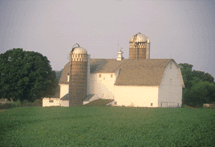The Midwest

The Midwest is a cultural crossroads. Starting in the early 1800s easterners moved there in search of better farmland, and soon Europeans bypassed the East Coast to migrate directly to the interior: Germans to eastern Missouri, Swedes and Norwegians to Wisconsin and Minnesota. The region's fertile soil made it possible for farmers to produce abundant harvests of cereal crops such as wheat, oats, and corn. The region was soon known as the nation's "breadbasket."
 |
Most of the Midwest is flat. The Mississippi River has acted as a regional lifeline, moving settlers to new homes and foodstuffs to market. The river inspired two classic American books, both written by a native Missourian, Samuel Clemens, who took the pseudonym Mark Twain: Life on the Mississippi and The Adventures of Huckleberry Finn.
Midwesterners are praised as being open, friendly, and straightforward. Their politics tend to be cautious, but the caution is sometimes peppered with protest. The Midwest gave birth to one of America's two major political parties, the Republican Party, which was formed in the 1850s to oppose the spread of slavery into new states. At the turn of the century, the region also spawned the Progressive Movement, which largely consisted of farmers and merchants intent on making government less corrupt and more receptive to the will of the people. Perhaps because of their geographic location, many midwesterners have been strong adherents of isolationism, the belief that Americans should not concern themselves with foreign wars and problems.
The region's hub is Chicago, Illinois, the nation's third largest city. This major Great Lakes port is a connecting point for rail lines and air traffic to far-flung parts of the nation and the world. At its heart stands the Sears Tower, at 447 meters, one of the world's tallest buildings.
